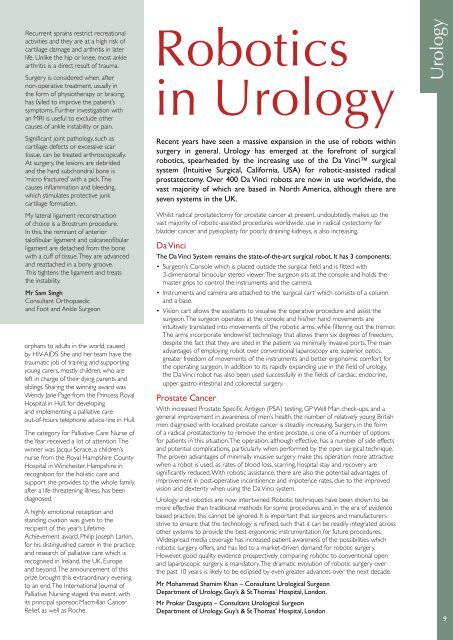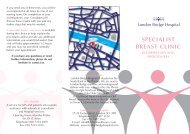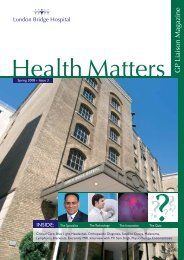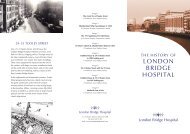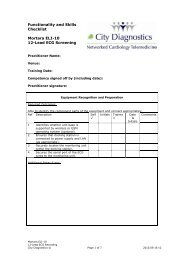407260LBH Health Matters.indd - London Bridge Hospital
407260LBH Health Matters.indd - London Bridge Hospital
407260LBH Health Matters.indd - London Bridge Hospital
Create successful ePaper yourself
Turn your PDF publications into a flip-book with our unique Google optimized e-Paper software.
Recurrent sprains restrict recreationalactivities and they are at a high risk ofcartilage damage and arthritis in laterlife. Unlike the hip or knee, most anklearthritis is a direct result of trauma.Surgery is considered when, afternon-operative treatment, usually inthe form of physiotherapy or bracing,has failed to improve the patient’ssymptoms. Further investigation withan MRI is useful to exclude othercauses of ankle instability or pain.Significant joint pathology, such ascartilage defects or excessive scartissue, can be treated arthroscopically.At surgery, the lesions are debridedand the hard subchondral bone is‘micro fractured’ with a pick. Thiscauses inflammation and bleeding,which stimulates protective junkcartilage formation.My lateral ligament reconstructionof choice is a Brostrum procedure.In this, the remnant of anteriortalofibular ligament and calcaneofibularligament are detached from the bonewith a cuff of tissue. They are advancedand reattached in a bony groove.This tightens the ligament and treatsthe instability.Mr Sam SinghConsultant Orthopaedicand Foot and Ankle Surgeonorphans to adults in the world, causedby HIV-AIDS. She and her team have thetraumatic job of training and supportingyoung carers, mostly children, who areleft in charge of their dying parents andsiblings. Sharing the winning award wasWendy Jane Page from the Princess Royal<strong>Hospital</strong> in Hull, for developingand implementing a palliative careout-of-hours telephone advice line in Hull.The category for Palliative Care Nurse ofthe Year received a lot of attention. Thewinner was Jacqui Scrace, a children’snurse from the Royal Hampshire County<strong>Hospital</strong> in Winchester, Hampshire inrecognition for the holistic care andsupport she provides to the whole family,after a life-threatening illness has beendiagnosed.A highly emotional reception andstanding ovation was given to therecipient of this year’s LifetimeAchievement award, Philip Joseph Larkin,for his distinguished career in the practiceand research of palliative care which isrecognised in Ireland, the UK, Europeand beyond. The announcement of thisprize brought this extraordinary eveningto an end. The International Journal ofPalliative Nursing staged this event, withits principal sponsor, Macmillan CancerRelief, as well as Roche.Roboticsin UrologyRecent years have seen a massive expansion in the use of robots withinsurgery in general. Urology has emerged at the forefront of surgicalrobotics, spearheaded by the increasing use of the Da Vinci surgicalsystem (Intuitive Surgical, California, USA) for robotic-assisted radicalprostatectomy. Over 400 Da Vinci robots are now in use worldwide, thevast majority of which are based in North America, although there areseven systems in the UK.Whilst radical prostatectomy for prostate cancer at present, undoubtedly, makes up thevast majority of robotic-assisted procedures worldwide, use in radical cystectomy forbladder cancer and pyeloplasty for poorly draining kidneys, is also increasing.Da VinciThe Da Vinci System remains the state-of-the-art surgical robot. It has 3 components:• Surgeon’s Console which is placed outside the surgical field and is fitted with3-dimensional binocular stereo viewer. The surgeon sits at the console and holds themaster grips to control the instruments and the camera.• Instruments and camera are attached to the ‘surgical cart’ which consists of a columnand a base.• Vision cart allows the assistants to visualise the operative procedure and assist thesurgeon. The surgeon operates at the console and his/her hand movements areintuitively translated into movements of the robotic arms, while filtering out the tremor.The arms incorporate ‘endowrist’ technology that allows them six degrees of freedom,despite the fact that they are sited in the patient via minimally invasive ports. The mainadvantages of employing robot over conventional laparoscopy are, superior optics,greater freedom of movements of the instruments and better ergonomic comfort forthe operating surgeon. In addition to its rapidly expanding use in the field of urology,the Da Vinci robot has also been used successfully in the fields of cardiac, endocrine,upper gastro-intestinal and colorectal surgery.Prostate CancerWith increased Prostate Specific Antigen (PSA) testing, GP Well Man check-ups, and ageneral improvement in awareness of men’s health, the number of relatively young Britishmen diagnosed with localised prostate cancer is steadily increasing. Surgery, in the formof a radical prostatectomy to remove the entire prostate, is one of a number of optionsfor patients in this situation. The operation, although effective, has a number of side effectsand potential complications, particularly when performed by the open surgical technique.The proven advantages of minimally invasive surgery make this operation more attractivewhen a robot is used, as rates of blood loss, scarring, hospital stay and recovery aresignificantly reduced. With robotic assistance, there are also the potential advantages ofimprovement in post-operative incontinence and impotence rates, due to the improvedvision and dexterity when using the Da Vinci system.Urology and robotics are now intertwined. Robotic techniques have been shown to bemore effective than traditional methods for some procedures and, in the era of evidencebased practice, this cannot be ignored. It is important that surgeons and manufacturersstrive to ensure that the technology is refined, such that it can be readily integrated acrossother systems to provide the best ergonomic instrumentation for future procedures.Widespread media coverage has increased patient awareness of the possibilities whichrobotic surgery offers, and has led to a market-driven demand for robotic surgery.However, good quality evidence prospectively comparing robotic to conventional openand laparoscopic surgery, is mandatory. The dramatic evolution of robotic surgery overthe past 10 years is likely to be eclipsed by even greater advances over the next decade.Mr Mohammad Shamim Khan – Consultant Urological SurgeonDepartment of Urology, Guy’s & St Thomas’ <strong>Hospital</strong>, <strong>London</strong>.Mr Prokar Dasgupta – Consultant Urological SurgeonDepartment of Urology, Guy’s & St Thomas’ <strong>Hospital</strong>, <strong>London</strong>Urology9


